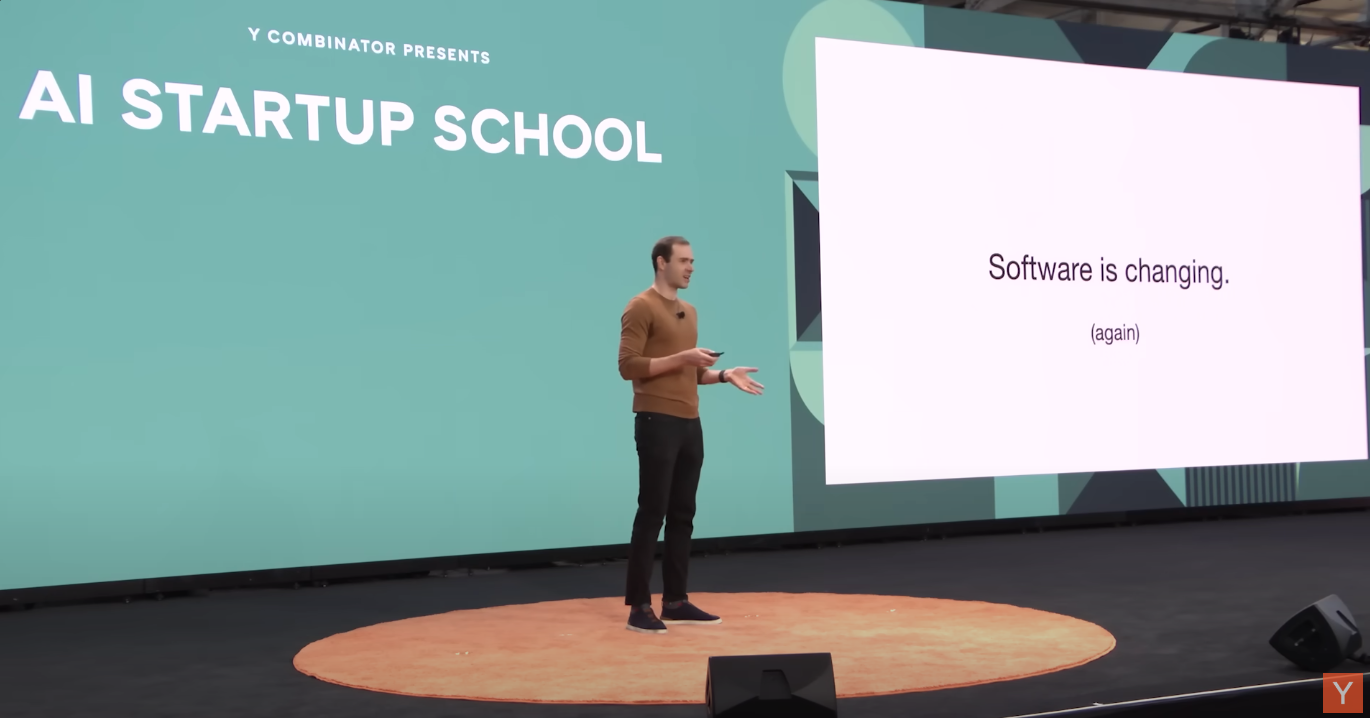If there’s one person who can explain the evolution of software with clarity, humor, and visionary depth, it’s Andrej Karpathy — former Tesla AI director and one of the most influential voices in AI. At Y Combinator’s first-ever AI Startup School, Karpathy delivered a mind-expanding talk on how AI is reshaping the software landscape — again — and what it means for the next generation of builders.
Here’s a deep dive into the key takeaways from his talk — packed with insights, analogies (hello Iron Man suits), and actionable advice for AI founders, devs, and curious minds alike.
🔁 Software Has Changed — Not Once, But Three Times
Karpathy lays out a timeline of software evolution:
1️⃣ Software 1.0 – Classic programming
You write explicit code to instruct a computer.
2️⃣ Software 2.0 – Neural networks
You train models by optimizing weights over data — no hand-written logic.
3️⃣ Software 3.0 – Large Language Models (LLMs)
Natural language becomes the new programming interface. Your prompts are your programs.
🧠 “Prompts are programs, written in English, executed by neural nets. That’s wild.”
🧭 LLMs Are the New Computers
Karpathy encourages us to treat LLMs as a new kind of programmable computer, with their own quirks and capabilities.
He maps the LLM ecosystem to something we’ve seen before: operating systems.
- 🧩 LLMs = CPU
- 📏 Context windows = memory
- 🔌 APIs = system calls
- 💻 Prompt interfaces = terminals
We’re in the 1960s of AI computing — cloud-based, centralized, shared resources. But soon, personal AI agents may run locally (hello, Mac Minis!).
👻 LLMs = People Spirits 🤯
One of the most striking metaphors of the talk:
“LLMs are like people spirits — stoic simulations of people with encyclopedic memory, but weird psychological quirks.”
Karpathy compares LLMs to savants (think Rain Man). They’re brilliant at some things — recalling facts, writing code — but also prone to:
- Hallucinations
- Memory loss (like in Memento or 50 First Dates)
- Strange mistakes (“9.11 > 9.9”, anyone?)
They’re powerful but fallible, so we need to build systems that embrace this duality.
🧠 Programming in English = Everyone Becomes a Coder
Thanks to LLMs, the barrier to software creation is dropping fast.
You don’t need to master Python or Swift. You just need a goal and the ability to describe it. That’s where vibe coding comes in — building apps by “vibing” with an AI co-pilot through conversation.
Karpathy even built a functional iOS app without knowing Swift, purely by prompting an LLM. Wild.
🛠️ We’re Building with Agents, Not Just for Humans
As LLMs and AI agents become increasingly integrated into our lives, we must start building software that agents can use, not just humans.
- Traditional docs, full of “Click here” instructions? Useless to an agent.
- Replace those with LLM-readable markdown, APIs, and
curlcommands. - Adopt standards like
llm.txtto guide agent behavior (just likerobots.txtfor web crawlers).
This is a paradigm shift. The users of your software may no longer be people — they may be AI agents acting on behalf of people.
🧩 Partial Autonomy Is the Way Forward (For Now)
We’re not in the age of fully autonomous agents yet — and that’s OK. Karpathy urges founders to build partial autonomy products:
- Human in the loop for verification
- AI for generation, augmentation, and context management
- A UI (GUI!) that helps people audit and guide the AI
He calls this the “Autonomy Slider”:
- Tap completion = low autonomy
- Code rewriting = medium autonomy
- Full repo refactoring = high autonomy
🦾 Think Iron Man suits, not Iron Man robots.
“Keep the AI on a leash. Let it assist, not run wild.”
🧪 Agent-First Software Design Is the Next Big Thing
LLMs need interfaces they can actually parse and interact with. That means rethinking how we design:
- Docs (machine-readable > flashy PDFs)
- APIs (direct access > click paths)
- Workflows (structured JSON > visual GUIs)
Tools like Deep Wiki, GetIngest, and LLM-friendly markdown are early examples of this trend.
💡 Final Thoughts: We’re Living in a Software Renaissance
“It’s the 1960s of operating systems again — but this time, billions of people have access overnight.”
Karpathy ends with a powerful call to arms: This is an unprecedented moment in tech. The software stack is being rewritten — not just how we build software, but who can build it.
And we all get to be a part of it.
🧰 TL;DR – Karpathy’s Playbook for the AI Era
- Understand the new paradigms – 1.0, 2.0, and now 3.0
- Treat LLMs as new computers – with operating systems, quirks, and capabilities
- Build partial autonomy products – keep humans in the loop
- Design for agents – create software interfaces LLMs can use
- Empower everyone to build – natural language is the new dev toolkit
- Think long-term – it’s not “the year of agents,” it’s the decade of agents
🌟 One Last Thought
Whether you’re a seasoned engineer or a student just entering the industry, now is the time to explore, build, and dream. The Iron Man suits are here — what you do with them is up to you.

Leave a Reply